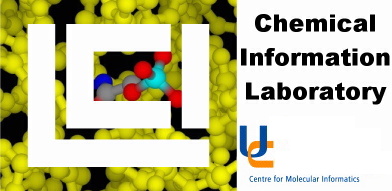
MOPAC
Mopac is a semi-empirical molecular orbital program, written
by J J P Stewart. It incorporates the common semi-empirical
Hamiltonians, AM1 and PM3. The version installed is MOPAC7
To run Mopac use
the rmopac command.
Type rmopac filename
where filename is a valid Mopac input file. You can
make a Mopac input file from a Macromodel file. Draw
the molecule you are interested in using Macromodel, then
write it to a file called aardvark or any other suitable
name. Quit Macromodel, and type mm2mop aardvark.
This will create two new files: aardvark.mmod and
aardvark.dat. The latter is a Mopac file.
Run it by typing: rmopac aardvark. The answer
to the question in the file will be put into a file called
aardvark.out.
The file produced by this procedure will do a single point
calculation on the structure that it is given. If you want
the structure to be minimised, then type mm2mopM
aardvark instead of mm2mop aardvark.
This will produce a file that minimises the structure.
If you want to do a MOPAC calculation on every structure
in a MacroModel output file, then use the mult2mop
command.
MOPAC calculations are much slower
that molecular mechanics, so this command should be used
with care.
This program takes a multistructure MacroModel file, converts each structure into a
Mopac input file, and minimises each one using AM1.
The program creates a new directory called mult2mop.filename and makes
a large number of files within it. The results are summarised
in the file: filename.fe
mult2mop only works with
the old format of MacroModel data file, and so the command m54
must be used to convert MacroModel 5.5 files to the old format.
Once you have run a Mopac calculation, you can change the
output file back into MacroModel format by typing
mop2mm aardvark.
If you are logged on to one of the Chemical Information
Laboratory's Linux PCs, you can click here to read the Mopac
help file
or the
manual. If you are not logged on to one of these machines,
clicking on these hyperlinks will give you an error message
but you can consult a version
at the CAOS centre in the Netherlands.
|